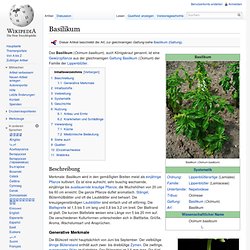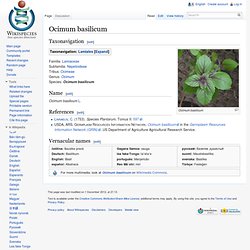

Basil. Most closely associated with Mediterranean cooking but also very prevalent in Asian food, the herb basil has a sweet, strong aroma and flavour.

There are three main Mediterranean types: sweet, with large green leaves; Greek, with smaller leaves and a peppery undertone; and purple, whose dark leaves have a milder flavour. Asian varieties include lemon basil, which has a citrus note and smaller leaves; Thai, like sweet basil, but stronger; and holy basil, spicy and intense, and unusual in that it's best when cooked, rather than raw. Availability All year round, but grows best during July and August. Save on packaging by buying a pot from your garden centre or supermarket - it will live quite happily on a sunny windowsill. Choose the best It's available freeze-dried, in sunflower oil or dried, but the best to use is fresh; either cut or potted.
Prepare it Pick fresh basil leaves from their stalks and scatter whole, or roughly torn, over dishes. Store it Cook it Alternatives Try rocket or parsley. List of basil cultivars. Basil cultivars vary in several ways.

Visually, the size and shape of the leaves varies greatly, from the large lettuce-like leaves of the Mammoth basil and Lettuce leaf basil to the tiny leaves of the Dwarf bush basil. More practically, the fragrance of the basil varies due to the varying types and quantities of essential oils contained in the plants. Basilikum. Beschreibung Generative Merkmale Die Blütezeit reicht hauptsächlich von Juni bis September.

Der vielblütige ährige Blütenstand enthält auch zwei- bis dreiblütige Zymen. Die zwittrige, zygomorphe Blüte ist fünfzählig. Der Blütenstiel ist 2,5 mm lang. Die Frucht ist 1,5 bis 2 mm lang und vom vergrößerten Kelch eingehüllt. Inhaltsstoffe Gehalt und Zusammensetzung des ätherischen Öls sind je nach Sorte, Herkunft und Erntezeitpunkt stark unterschiedlich. Verbreitung Das natürliche Verbreitungsgebiet des Basilikum umfasst das tropische Afrika und Asien.[2] Systematik Der Artname Ocimum basilicum wurde 1753 durch Carl von Linné in Species Plantarum, 2, S. 597[3] erstveröffentlicht.
Basilikum wird in zwei Unterarten gegliedert,[4] daneben gibt es noch andere Unterteilungen in verschieden viele Varietäten: Ocimum basilicum L. subsp. basilicum, die in Europa vorkommende Form.Ocimum basilicum subsp. minimum L., wird in Indien vielfach als Zierpflanze kultiviert. Es gibt mehrere Varietäten (Auswahl):[5] Basil. There are many varieties of Ocimum basilicum, as well as several related species or species hybrids also called basil.

The type used in Italian food is typically called sweet basil, as opposed to Thai basil (O. basilicum var. thyrsiflora), lemon basil (O. X citriodorum) and holy basil (Ocimum tenuiflorum), which are used in Asia. While most common varieties of basil are treated as annuals, some are perennial in warm, tropical climates, including holy basil and a cultivar known as 'African Blue'. Etymology[edit] The word basil come from the Greek βασιλεύς (basileus), meaning "king",[4] as it has come to be associated with the Feast of the Cross commemorating the finding of the True Cross by St Helena mother of the emperor St. Nomenclature and taxonomy[edit] Most commercially available basils are cultivars of sweet basil. Ocimum basilicum. [edit] Ocimum basilicum Familia: Lamiaceae Subfamilia: Nepetoideae Tribus: Ocimeae Genus: Ocimum Species: Ocimum basilicum Name[edit] Ocimum basilicum L.

References[edit] Linnaeus, C. (1753). Vernacular names[edit] čeština: Bazalka praváDeutsch: BasilikumEnglish: Basilespañol: AlbahacaGagana Samoa: saugalea faka-Tonga: taʻetaʻeportuguês: ManjericãoReo Mā`ohi: miriрусский: Базилик душистыйsuomi: Maustebasilikasvenska: BasilikaTürkçe: Fesleğen. Ocimum basilicum (Sweet basil)